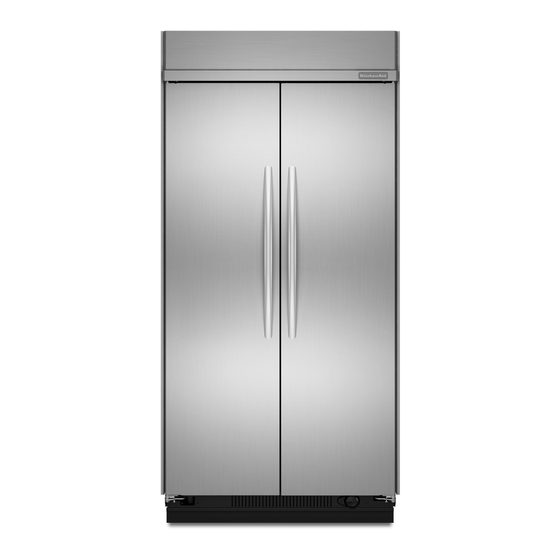Table of Contents
Advertisement
Tools and Parts
IMPORTANT:
Installer: Leave Installation Instructions with the homeowner.
Homeowner: Keep Installation Instructions for future
reference. Save these Installation Instructions for the local
electrical inspector's use.
TOOLS NEEDED:
Gather the required tools and parts before starting installation.
Read and follow the instructions provided with any tools listed
here.
Hand drill or electric drill
(properly grounded)
Drill bits
Two adjustable wrenches
Phillips screwdriver
Small level
Appliance dolly
PARTS NEEDED:
Six #8 x 3" (7.6 cm) wood screws (longer screws may be needed)
One or two 2" x 4" x 32" (5 cm x 10 cm x 81 cm) wood board(s)
Order factory panels, make custom panels or consult a
qualified cabinetmaker or carpenter to make the panels.
Classic Series: Order factory panels, make custom panels, or
consult a qualified cabinetmaker or carpenter to make the
panels. See "Classic Series Custom Panels" for more
information.
Overlay Series: Make custom panels, or consult a qualified
cabinetmaker or carpenter to make the panels. See "Overlay
Series Custom Panels and Handle Kits" for more information.
Architect
®
and Complete Series are shipped complete.
If you are connecting the water line directly to copper tubing
and not to a shutoff valve, you need a ferrule, a union, and a
¹⁄₄" (6.35 mm) compression fitting.
†®TORX is a registered trademark of Textron Innovations Inc.
6
INSTALLATION REQUIREMENTS
Torx
®†
T27 screwdriver
¹¹⁄₃₂" nut driver
³⁄₈" and ¹⁄₂" open-end
wrenches
⁵⁄₃₂" Allen wrench
¹⁄₄" and ⁵⁄₁₆" socket drivers
Tape measure
Utility knife
Location Requirements
The refrigerator can be recessed in an opening between cabinets
or installed at the end of a cabinet run using a side panel to
enclose the refrigerator.
WARNING
Explosion Hazard
Keep flammable materials and vapors, such as
gasoline, away from refrigerator.
Failure to do so can result in death, explosion, or fire.
IMPORTANT:
Observe all governing codes and ordinances.
It is recommended that you do not install the refrigerator near
an oven, radiator, or other heat source.
Do not install in a location where the temperature will fall
below 55°F (13°C).
Floor must support the refrigerator weight, more than 600 lbs
(272 kg), door panels and contents of the refrigerator.
Ceiling height must allow for side tipping radius. See "Tipping
Radius."
Location should permit door to open fully. See "Door Swing
Dimensions."
Location must permit top grille removal. See "Opening
Dimensions."
Opening Dimensions
To avoid tipping during use, the solid soffit must be within 1"
(2.5 cm) maximum above the refrigerator. If the solid soffit is
higher than 1" (2.5 cm) or one is not available, then the
refrigerator must be braced.
If the anti-tip boards are needed, they must be attached to
the rear wall studs 80" to 90" (203 cm to 229 cm) above the
floor. See "Install Anti-Tip Boards" for more information.
NOTE: A clearance of ¹⁄₂" (1.3 cm) must be maintained above
the top grille in order for the top grille to be removed.
¹⁄₂
"
(1.3 cm)
Advertisement
Table of Contents

Summarization of Contents
Tools and Parts
Installation Tools and Parts
Lists essential tools and parts required for refrigerator installation.
Location Requirements
Safety and Placement Guidelines
Crucial safety warnings and optimal placement advice, including explosion hazards and temperature.
Clearance and Support Specifications
Details on necessary clearances and structural support for safe operation.
Electrical Requirements
Electrical Safety Warnings
Critical warnings regarding electrical shock hazards and proper grounding.
Grounding and Power Supply
Guidelines for a safe and dedicated electrical supply and grounding method.
Water Supply Requirements
Plumbing and Water Pressure
Instructions for connecting water supply, pressure needs, and reverse osmosis systems.
Tipping Radius and Stability
Ceiling Height and Side Tipping
Information on ensuring adequate ceiling height and managing tipping radius.
Product Dimensions
Refrigerator Dimensions Overview
Provides key dimensional data for side, front, and top views of the refrigerator.
Door Swing Dimensions
Clearance for Door Operation
Details required space for doors to open fully for different models.
Overlay Series Custom Panels and Handle Kits
Custom Panel Specifications
Guidelines and dimensions for creating custom overlay panels and backer panels.
Panel Weight Limits
Important weight restrictions for overlay door and grille panels.
Classic Series Factory Panels and Kits
Factory Door Panel Options
Details on available factory-made door panel kits for different models.
Classic Series Custom Panels
Custom Panel Creation Guidelines
Instructions and warnings for creating custom wood panels for the refrigerator.
Top Grille Panel Requirements
Specifications and weight limits for the top grille panel.
Door Panels – Routing Requirements
Standard and Extended Handle Routing
Guides for routing door panels for standard and extended handles.
Custom Side Panels
Side Panel Installation Types
Options for custom side panel installation (Inset, Flush, Recessed).
Unpack the Refrigerator
Tip Over Hazard Warning
Critical safety warning about the refrigerator's tip-over risk during installation.
Initial Unpacking Steps
Procedures for safely unpacking the refrigerator and removing shipping materials.
Reduce Tipping Radius
Tipping Radius Reduction Steps
Instructions on how to reduce the tipping radius by removing trims.
Move the Refrigerator into House
Appliance Dolly Usage
Guidance on using an appliance dolly to safely move the refrigerator.
Install Anti-Tip Boards
Anti-Tip Board Installation
Step-by-step instructions for attaching anti-tip boards to prevent tipping.
Connect the Water Supply
Style 1 - Shutoff Valve Connection
Detailed steps for connecting the water supply using a shutoff valve.
Style 2 - Copper Line Connection
Detailed steps for connecting the water supply via a copper pipe.
Connecting to Refrigerator
Steps to connect the water supply tubing to the refrigerator itself.












Need help?
Do you have a question about the KSSC42FT and is the answer not in the manual?
Questions and answers